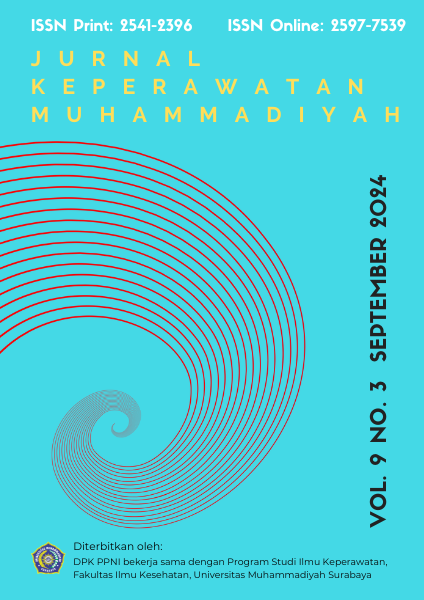PENGARUH KARAKTERISTIK IBU HAMIL TERHADAP SELF EFFICACY DETEKSI TANDA BAHAYA KEHAMILAN
DOI:
https://doi.org/10.30651/jkm.v9i3.25495Keywords:
Characteristics, Self-Efficacy, Pregnancy Danger SignsAbstract
Objective: Maternal mortality, as defined by the World Health Organization (WHO), refers to death occurring during pregnancy or within 42 days of its occurrence, from conditions related to the pregnancy and its management, without being caused by injury or accident (Collier et al., 2020). In Indonesia, the maternal mortality rate (MMR) was recorded at 305 per 100,000 live births, caused by hypertension (9.62%), bleeding (9.38%), and other factors (68.18%). To reduce MMR globally, various programs have been implemented, including the Safe Motherhood Program, Childbirth Planning and Complication Prevention (P4K), and Penakib.
Methods: The design of this study was Data analysis using Spearman's rho. The results of the study showed that the level of education and the number of pregnancies greatly affect self-efficacy. This is because the level of education and experience in pregnancy make mothers confident and motivated to maintain their health and that of their fetuses through early detection of pregnancy danger signs.
Results: This study aims to explore the characteristics of pregnant women towards self-efficacy in detecting pregnancy danger signs. The quantitative correlational research method with a cross-sectional approach, with a population of 150 pregnant women and 115 respondents as samples.References
Arikunto, S. (1993). Prosedur Penelitian Suatu Pendekatan Praktik (edisi revisi II, Cetakan Kesembilan). Rineka Cipta.
Arikunto, S. (2005). Prosedur Penelitian Suatu Pendekatan Praktek. Rineka Cipta.
Bandura, Albert, A. P. C. company, & 1976. (n.d.). Social Learning Theory.
Dinas kesehatan Provinsi Jawa Timur. (n.d.). Profil Kesehatan 2021.
Mbalinda, S. N., Nakimuli, A., Kakaire, O., Osinde, M. O., Kakande, N., & Kaye, D. K. (2014). Does knowledge of danger signs of pregnancy predict birth preparedness? A critique of the evidence from women admitted with pregnancy complications. Health Research Policy and Systems, 12(1). https://doi.org/10.1186/1478-4505-12-60
Mugheed, K. A.-, & Bayraktar, N. (2023). efficacy , attitudes , and behaviour ’ s towards venous thromboembolism among nurses : A systematic review. June, 6033–6044. https://doi.org/10.1002/nop2.1914
rohmatin deteminant kematian ibu di surabaya. (n.d.).
Sukarsih, R. I., & Adyani, A. (2022). J ur nal K e p e r a w a t a n M u h a m m a d i y a h. 7(3), 126–129.
Tanhan, A., & Young, J. S. (2022). Muslims and Mental Health Services : A Concept Map and a Theoretical Framework. In Journal of Religion and Health (Vol. 61, Issue 1). Springer US. https://doi.org/10.1007/s10943-021-01324-4
Wang, Y., & Ji, Y. (2021). How do they learn: types and characteristics of medical and healthcare student engagement in a simulation-based learning environment. BMC Medical Education, 21(1), 1–13. https://doi.org/10.1186/s12909-021-02858-7
Downloads
Published
Issue
Section
License
Copyright (c) 2024 Rachmawati Ika Sukarsih

This work is licensed under a Creative Commons Attribution-ShareAlike 4.0 International License.
- Penulis tetap memegang hak atas karyanya dan memberikan hak publikasi pertama kepada jurnal ini yang secara simultan karya tersebut dilisensikan di bawah:Â Creative Commons Attribution-ShareAlike 4.0 International (CC BY-SA 4.0)













